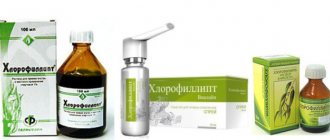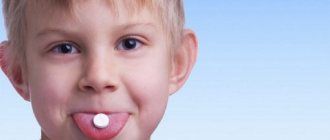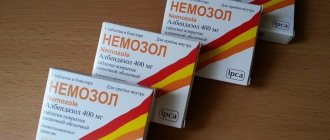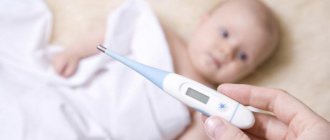How to increase hemoglobin in a baby
Parents are concerned about the child’s health from the first days of his life.
An important role in the baby’s well-being is played by the supply of vitamins and microelements necessary for growth. One of these is iron. Its deficiency occurs in children much more often than in adults. To figure out why this is and what to do about it, let's first cover terms like “hemoglobin” and “anemia” and understand the role of iron in the body.
Hemoglobin is a protein found in red blood cells. It is responsible for the transfer of oxygen from the lungs to cells and for the return transfer of carbon dioxide. This most directly affects the maintenance of acid-base balance in the human body. The higher the hemoglobin level, the better oxygen supply to all body tissues, which means the proper functioning of internal organs is ensured. What gives this protein the ability to retain and transport oxygen and return carbon dioxide through the veins? This is precisely iron.
Anemia is considered to be a decrease in the level of hemoglobin in the blood to a state in which the ability of blood cells to carry oxygen to tissues and organs is significantly reduced. It can be caused by other reasons, but most often it is due to a lack of iron.
Children suffer from a decrease in hemoglobin more often than adults because their circulatory system is not yet perfect. In addition, children grow quickly and need more nutrients. That is why all parents need to be savvy in maintaining normal hemoglobin levels in their babies. If you have any suspicions that your baby has low hemoglobin (indirect signs of this condition will be described below), it would be good to talk with a qualified neonatologist whom you can trust in such matters.
Why is anemia dangerous?
The consequences of iron deficiency extend to many important systems of the body. This is understandable: if there is not enough hemoglobin, then the whole body suffers. He doesn't get enough oxygen. The negative impact of anemia on the central nervous system slows down the mental development of the child. Immunity also suffers. Iron deficiency contributes to an increase in colds, viral diseases and intestinal infections.
What are the causes of anemia
Among the causes of anemia in infants, several groups can be distinguished.
The first is congenital anemia, which most often develops as a result of the mother’s monotonous, meager diet during pregnancy. And also due to infectious diseases suffered by the mother and intoxication during pregnancy. Elimination of such anemia must be approached comprehensively, most often with the participation of a doctor.
The second is acquired during childbirth. This also includes anemia resulting from birth injuries. If a baby loses a lot of blood during birth, his hemoglobin levels drop significantly. Premature birth, multiple or premature pregnancy can also cause insufficient hemoglobin. Major blood loss in a baby occurs when the placenta abruptly separates or the umbilical cord ruptures. Premature cord ligation can also cause iron deficiency anemia. The umbilical cord needs to be tied only after the pulsation has stopped. This minimizes the risk of developing anemia.
The third group is anemia acquired after birth as a result of negative external influences (deficiency in the baby’s nutrition, poisoning, infections, etc.).
How does anemia manifest itself?
Signs of anemia in a child may include the following changes:
- Pale skin, dark circles under the eyes.
- Fatigue is easy, the child often asks to be held.
- Refuses to eat, burps profusely and frequently.
- Loses consciousness.
- The baby is too calm, prefers not to run, but to sit, play calm games and sleep a lot.
- Dry skin, brittle nails, dull hair, skin wounds take a long time to heal.
- Teeth, if they have already erupted, begin to decay.
- Inflammation of the oral mucosa and eyelids appeared.
- Increased sweating, shortness of breath, rapid pulse.
- Immunity decreases, resulting in frequent colds.
- Significant inhibition in psychomotor and physical development.

Several factors that affect hemoglobin levels
When trying to figure out what to do with low hemoglobin in children, you should understand that its content in the blood depends on several points:
- Age characteristics. In infants who have just been born, the greatest intensity is observed. Then it decreases. So, an indicator of 120 g/l indicates low hemoglobin in a child at 3 months, and for a one-year-old baby this is the norm.
- Mother's pregnancy. If a woman had hematopoietic diseases during pregnancy or suffered global blood loss during childbirth, this will affect the baby’s hemoglobin level. As well as a history of premature birth and multiple pregnancies.
- Food. If a child is breastfeeding, then low hemoglobin will be observed occasionally. Artificial children suffer from deficiency more often. Also, the level of hemoglobin indicators can be affected by a violation in the diet of a baby who is older than six months. For example, if the mother does not introduce complementary foods for a long time, does not give the baby meat, etc.
- Health. Reduced hemoglobin in a child can be observed if the baby has hidden diseases.
- Heredity. If the child’s parents have long-term anemia, it is not surprising that this condition will be passed on to the baby.
- Seasons. The greatest drop in hemoglobin levels in the blood of children is observed in autumn and winter.
How to increase hemoglobin in a breastfed baby
Every effort must be made to establish breastfeeding, and for the first months (or even years) of the baby’s life, breastfeed. This will be the best prevention of anemia in a child. Immediately after birth, you need to put the baby to the breast, then colostrum, once in the baby’s intestines, will start the normal functioning of the gastrointestinal tract. Thus, the intestinal cells will learn to absorb all the necessary substances from food, including iron. If you breastfeed your baby, he will get everything he needs from your milk. According to one version, the mother’s nutrition does not even matter for the composition of human milk. In any case, iron will be secreted in the volume required by the child and will be almost completely absorbed from the digestive tract.
How to increase hemoglobin in a baby who has already been introduced to complementary foods
If the child has already been introduced to complete complementary feeding (preferably no earlier than six months), then hemoglobin can be increased by adding the iron-containing products listed above to his diet. If your baby is introduced to complementary foods before six months, the absorption of iron from breast milk will become worse. It has also been noted that anemia is common in children who are fed cow's and goat's milk. This is due to the fact that these products do not contain enough microelements necessary for hematopoiesis. In addition, the baby’s body is often unable to break down cow protein.
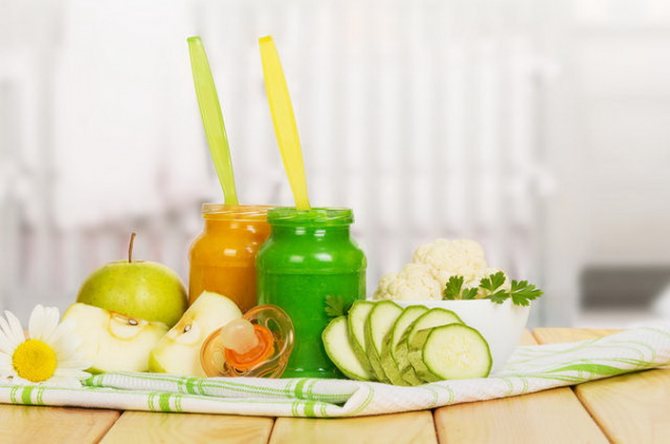
Be sure to include berries in your child’s diet (even frozen or dried, if it’s winter): blueberries, strawberries, black currants, cranberries.
How else can you increase hemoglobin in an infant?
An important factor in the treatment of anemia in infants is the normalization of the daily routine. Provide your baby with adequate sleep, long walks in the fresh air (1.5–2 hours a day), the opportunity to move a lot, and strengthen him. These factors also play a significant role in increasing hemoglobin.
Among some naturopaths there is still an opinion that the child’s hemoglobin is influenced by the emotional state of the mother. According to this theory, if a mother is full of fears, then these fears block the flow of life (which is equivalent to the flow of blood) both through her channels and through the channels of the child. If there is no place for joy and a smile in her life, but there is a lot of anger and resentment, then changing her diet will most likely not change anything. If you find a resource of inner joy in yourself, stop “spoiling” your blood, stop sorting things out with your family, then this is how you can increase your baby’s hemoglobin.
source
How to prevent low hemoglobin in newborns?
- Monitor hemoglobin levels during pregnancy . The expectant mother should have a complete diet, including a sufficient amount of iron-containing food, so that the fetus accumulates the required amount of iron before birth. Pregnant women are often prescribed iron supplements to help maintain iron levels in the blood.
- Breastfeed your baby longer. Lactoferrin, present in breast milk, promotes iron absorption.
- A nursing mother needs to eat right , include as many iron-containing foods in her diet as possible and give up tea, as it negatively affects iron absorption.
- Walk more in the fresh air and move. At the same time, the blood is saturated with oxygen.
- Adapted mixtures should contain increased levels of iron , magnesium and other useful elements.
- Timely introduction of complementary foods will also help avoid anemia. The baby is growing and needs more nutrients than it can get from mother's milk or formula.
- Prophylactic intake of iron-containing drugs. This is especially necessary for premature babies, twins and triplets, children with underweight or, conversely, with intense weight gain.
When a baby has low hemoglobin, Komarovsky recommends walking more in the fresh air and giving the baby buckwheat porridge and meat to eat.
If there is a strong drop in red blood cells, the administration of red blood cell mass is prescribed. Massage helps a lot with low hemoglobin in a baby.
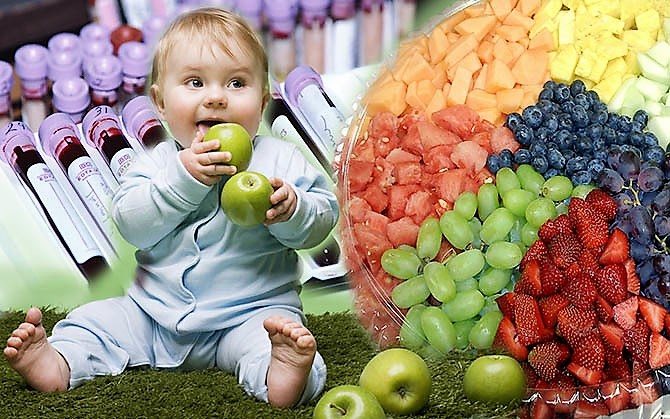
Causes
The following factors lead to a low hemoglobin level:
- Protein deficiency in a child occurs when an insufficient amount of iron enters the body. Approximately 5% of this trace element is excreted naturally every day. Its reserves are replenished through proper nutrition.
- Iron is intensely lost during bleeding. In teenage girls, hemoglobin concentration drops during menstruation.
- A breastfed baby does not experience a lack of iron-containing protein if it is fed with breast milk. Artificial feeding, for which cow's milk is taken, sometimes leads to iron deficiency. In this product it is in a bound state and cannot be isolated.
- Anemia occurs with enteritis, gastritis, and peptic ulcers, in which the absorption of nutrients through the mucous membranes of the digestive tract is reduced. Because of this, insufficient iron enters the blood.
- Low hemoglobin levels are caused by a deficiency of vitamin B12, a compound that transports iron into the bloodstream..
- When a pregnant woman eats poorly or irrationally, or suffers from a cold, little iron accumulates in the baby’s liver. In this case, the newborn suffers from hemoglobin deficiency immediately after birth.
- Hemoglobin drops if children are poisoned with toxic substances that can destroy red blood cells.
Reasons for violation
The main causes of low hemoglobin in infants include:
- significant blood loss;
- disruption of iron absorption due to nonspecific ulcerative colitis and other pathologies;
- increased iron consumption due to chronic diseases or congenital heart disease;
- fixation of iron during pathological processes by macrophages.
Repeated blood loss increases iron deficiency, which initially manifests itself as latent and later obvious anemia. Often, blood loss in newborns occurs in the digestive canal. The reason for this may be the development of a diaphragmatic hernia, ulcerative colitis, hemorrhagic disease, or cerebral hemorrhage.
Impaired iron absorption may be a consequence of small intestinal resection, which is most often caused by treatment failure.
Redistribution of iron may occur in the newborn's body. This sometimes results from chronic infection or connective tissue disease. When a child is sick with such diseases, iron is not used in the process of erythropoiesis (blood formation), but to fight infections.
Iron deficiency anemia develops most often in newborns who are irrationally or artificially fed.
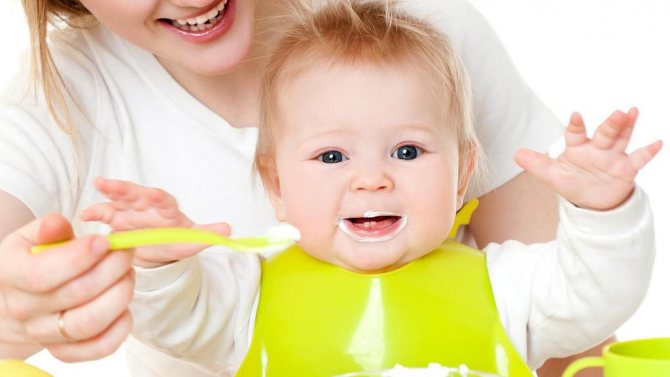
In addition, this problem can occur in a baby whose mother did not have proper nutrition during pregnancy and did not form an iron reserve for the baby.
Acceptable standards
Hemoglobin concentration in childhood varies:
- in a newborn in the first three days it reaches 180–240 g/l;
- in infants up to a month – 115–175 g/l;
- in a baby 2–12 months – 110–135 g/l;
- from one year to 12 years of age – 110–145 g/l;
- in adolescents – 120–155 g/l.
When a baby’s hemoglobin is low, its level is quickly raised with iron-containing medications. There are medications for children aged 1 year. However, in the early stages of anemia development, pediatricians insist on correcting the nutrition of the infant and mother. They are advised to eat foods rich in iron.
Table of norms for hemoglobin indicators in children of different ages
Before you figure out what to do with low hemoglobin in children, you need to understand that its level fluctuates and, above all, depends on the age of the baby. Thus, tests will reveal a greater amount of hemoglobin and red blood cells in the blood of a newborn baby than in older children. In the first 12 months of a child’s life, there is a natural decrease in the level of iron-containing protein in the blood, and this is acceptable for infants.
Hemoglobin level in the blood of children under one year of age:
| Baby's age | Ideal g/l value | Permissible norm g/l |
| 1st 24 hours of life | 220 | 180-240 |
| Fifth day | 190 | 160-200 |
| Tenth day of life | 180 | 160-190 |
| First month | 175 | 160-190 |
| Two month | 150 | 120-160 |
| Three months | 140 | 120-160 |
| 120 days | 135 | 120-140 |
| Five months | 135 | 120-140 |
| Six months of life | 130 | 120-140 |
| Seven months | 130 | 120-140 |
| Eight months | 130 | 120-140 |
| Nine month | 130 | 120-140 |
| Ten months | 125 | 110-140 |
| Eleven months | 125 | 110-140 |
| Year of life | 120 | 110-140 |
Symptoms
With anemia, a child experiences:
- poor appetite;
- fatigue, weakness;
- drowsiness;
- decreased activity;
- apathy;
- dizziness;
- cracks in the corners of the lips.
The child’s nails break, hair loses its shine, becomes dull, falls out, the skin turns pale and acquires a yellowish tint. The epithelium is dry, flaky. There are dark circles under the eyes, the heart rate is increased. Immunity is low, the baby is constantly sick. Diseases are difficult and cause complications. If iron deficiency is not corrected, children experience delayed physical and mental development.
Signs of the condition
Before you understand what to do with low hemoglobin in children, you need to understand what the signs of the disease are. So, the manifestations are as follows:
- The skin is pale.
- The child is lethargic and gets tired quickly.
- The baby experiences weakness, dizziness and circles under the eyes.
- The baby wants to sleep.
- The child's temperature rises and the structure of the nail plates changes.
- The baby eats and sleeps poorly and is mostly in a bad mood.
- The baby often picks up viral infections, his skin peels and becomes dry.
If the described symptoms appear, you need to consult a doctor, otherwise the baby will develop tachycardia, shortness of breath and will lag behind in development.
Drug therapy
Iron deficiency anemia usually occurs in children. If hemoglobin levels are low, both the one-year-old baby and the older child need urgent treatment. A pediatrician determines the cause of anemia and prescribes treatment.
If you have iron deficiency anemia, you need to adjust your diet and take medications prescribed by your doctor. Medicines are prescribed for three months. An increase in hemoglobin occurs if the child takes:
- long-acting medications: Ferograd, Ferrum-lek, Irovit;
- short-term agents: Ferrous fumarate, Ferrous sulfate.
If an infant or young child is sick, the doctor will prescribe drops or syrup. Children with fears are given chewable lozenges; the active substances from them are gradually absorbed into the blood from the intestines.
Positive dynamics should occur after 30 days of treatment. It is determined by blood tests. The lack of therapeutic effect is due to:
- wrong dose;
- misdiagnosis (non-iron deficiency anemia);
- Irregular use of medications.
Diet therapy
A nursing mother and baby must follow a special diet. Beef is the main product that replenishes iron deficiency . The meat is boiled or steamed. The menu includes offal: kidneys, liver, as well as meat from other animals.
Fish does not contain much iron. The body will be more quickly saturated with microelements if you add seafood dishes (caviar, shrimp) to your diet.
Plant foods such as legumes and buckwheat help increase hemoglobin. It is healthy to eat beans, peas, lentils, as well as rye and wheat bread.
Vegetables, berries, and fruits eliminate the lack of iron-containing protein. Hemoglobin increases if children eat beets, potatoes, tomatoes, gooseberries, apples, carrots, zucchini, pomegranates, quince, rose hips, pears, strawberries, watermelons, raspberries, persimmons, and currants.
In order for foods that increase hemoglobin in children to be beneficial, it is necessary to remove foods containing calcium from the diet. This trace element makes it difficult to absorb iron. During the diet, dairy products are given to children in limited quantities (breast milk cannot be excluded). Milk, cottage cheese, sour cream, yogurt, and kefir are temporarily removed from the diet.
To increase the concentration of iron-containing protein, restrictions are imposed on caffeinated drinks. Instead of tea, Coca-Cola, and cocoa, jelly, compotes, fruit drinks, herbal infusions, and juices are prepared.
Traditional treatment
If the mother monitors the child’s health, controls his diet, and uses folk remedies that maintain hemoglobin concentration within acceptable limits, he will not develop anemia. It is possible to raise a child’s hemoglobin level without medications. It is enough to use folk recipes that have stood the test of time.
Simple remedies can help increase iron concentration. Children use many of them with pleasure. They increase hemoglobin in infants aged 7 months and older children.
A particular home remedy should not be used if it causes an allergic reaction or other side effect. If undesirable manifestations occur (rash, itching, etc.), the drug is discontinued.
It is possible to increase the concentration of iron-containing protein using:
- Decoction of rose hips. Take 5 tablespoons of berries and infuse them in 1 liter of boiling water. The product is given to the baby in the morning. Add 0.5 teaspoon of honey and a little lemon juice to 0.5 cups of extract.
- A mixture of buckwheat and walnuts helps raise the level of iron-containing protein. The ingredients are ground to a powder and combined with honey. All components are taken in equal quantities, 1 glass each. The dose for a one-year-old baby is 1 tablespoon per day.
- Fruit and honey mixture. Walnut kernels, raisins, dried apricots are ground in a blender and combined with honey in equal quantities. Take a teaspoon 2-3 times a day.
- If hemoglobin is low, use fresh fruit and vegetables. Give children apple juice mixed with carrot and beetroot in proportions 2:1:1. Daily dose – 200–250 ml.
- Fruit-honey mixture with aloe. Grind walnuts, dried apricots, prunes, raisins, honey and juice obtained from aloe leaves are mixed. The ingredients are taken in equal quantities. Use 2-3 teaspoons daily.
- To quickly replenish iron deficiency, use a simple folk recipe. Thanks to him, anemia is treated even in tiny children. Oat grains are simmered in milk for an hour. For 500 ml of milk take ½ cup of oats. Babies are given a teaspoon. Older children drink the decoction as tea.
- Herbal collection. Boil 750 ml of water and pour into a thermos. Add 3 tablespoons of St. John's wort, blackberry and chamomile, 2 tablespoons of nettle, leave. Drink 250 ml warm three times a day.


